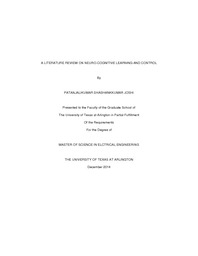
ATTENTION: The works hosted here are being migrated to a new repository that will consolidate resources, improve discoverability, and better show UTA's research impact on the global community. We will update authors as the migration progresses. Please see MavMatrix for more information.
Show simple item record
| dc.contributor.author | Joshi, Patanjalikumar Shashankkumar | en_US |
| dc.date.accessioned | 2015-07-01T17:50:22Z | |
| dc.date.available | 2015-07-01T17:50:22Z | |
| dc.date.issued | 2014-12 | |
| dc.date.submitted | January 2014 | en_US |
| dc.identifier.other | DISS-12886 | en_US |
| dc.identifier.uri | http://hdl.handle.net/10106/24924 | |
| dc.description.abstract | This thesis is an effort to provide a foundation work linking neuroscience, psychology and control theory as a part of research going on developing fast satisficing autonomous systems at the University of Texas at Arlington Research Institute (UTARI). This literature review, the compilation is aimed to facilitate information and references needed for neurocognition and control. There is so much research going on to understand the neural mechanisms of a mammal brain, especially human brain. Although it is not fully understood, there are proposed and proven theories that address intelligence, various learning and decision making processes performed by various parts of the brain. Cerebellum is hypothesized to be responsible for supervised learning, cerebral cortex for unsupervised learning and basal ganglia for reinforcement learning with help of dopamine. Probability, the representation of data and emotions do affect the decision process. A shunting inhibitory neural network which include amygdala, orbitofrontal cortex, ventral striatum, thalamus and anterior cingulated cortex, is involved when the decision process is affected by probability and emotions. That is related with gist and verbatim, too. Cognitive abilities also make difference in decisions. It is proposed that there are multiple learning and control loops in the brain. With aim of replicating brain-like intelligence, multiple actor-critics solve Bellman equation using approximate dynamic programming for optimal control. Multiple model based architectures for learning and control have been proposed which also find optimal control for systems. These architectures include artificial neural network which utilize shunting inhibition and multiple model reinforcement learning. Still, to achieve brain-like intelligence, optimality is not necessary. Satisficing decision has to only meet only some minimum acceptance; it does not have to be optimal, so it can be faster. Inclusion of satisficing in multi-player games is beneficial. Also, it is not always possible to make optimal choices due to various limitations, so with a bounded rationality, choices have to be made. Finally, the goal is to develop a framework that can learn and control various systems, fast and efficiently with limited resources and rapidly changing environment. | en_US |
| dc.description.sponsorship | Lewis, Frank | en_US |
| dc.language.iso | en | en_US |
| dc.publisher | Electrical Engineering | en_US |
| dc.title | A Literature Review On Neuro-cognitive Learning And Control | en_US |
| dc.type | M.S. | en_US |
| dc.contributor.committeeChair | Lewis, Frank | en_US |
| dc.degree.department | Electrical Engineering | en_US |
| dc.degree.discipline | Electrical Engineering | en_US |
| dc.degree.grantor | University of Texas at Arlington | en_US |
| dc.degree.level | masters | en_US |
| dc.degree.name | M.S. | en_US |
Files in this item
- Name:
- JOSHI_uta_2502M_12886.pdf
- Size:
- 1.780Mb
- Format:
- PDF
This item appears in the following Collection(s)
Show simple item record


